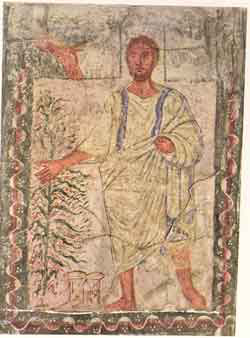Noah's Ark is certainly one of the most widely known of all biblical images, particularly popular with and for children.
The Lord said to Noah
There’s gonna be a floody floody
Get those animals out of the muddy muddy
Children of the Lord.
Chorus: Rise and shine and give God his glory, glory
Rise and shine and give God his glory, glory
Children of the Lord!
Oh Noah, he built him, he built him an arky arky
Oh Noah, he built him, he built him an arky arky
Built it out of hickory barky barky
Children of the Lord!...
The animals, they came in, they came in by twosie, twosies
The animals, they came in, they came in by twosie, twosies
Elephants and kangaroosie, roosies, children of the Lord
This spectacle of a primeval circus has naturally delighted people of all ages and eras. But, examination of the biblical account reveals that Noah's tale is more essentially a story of divine wrath, universal destruction and death. How has this dour and frightening biblical legend become a charming fairy tale? One key to understanding this transformation can be sought in Pope Gregory the Great's formative statement, in defense of the use of art by the Church: "what writing presents to readers, a picture presents to the unlearned who behold, since in it even the ignorant see what they ought to follow; in it the illiterate read." Here we will sample some of the artwork produced over the generations regarding central episodes of the Flood story, in search of the ways in which artists have understood and taught their lessons.
The Call
The text of Genesis 6:9 identifies Noah as "entirely righteous in his generations" and therefore deserving to be saved from the impending disaster. Midrash comments mainly on "in his generations", measuring the degree of righteousness and leaving us to question whether at another time he would be either lesser or greater. "In his generations" also suggests that the widespread evil was so great that being even a little righteous would be praiseworthy. The speculation about the character of Noah is expressed differently by the following images.
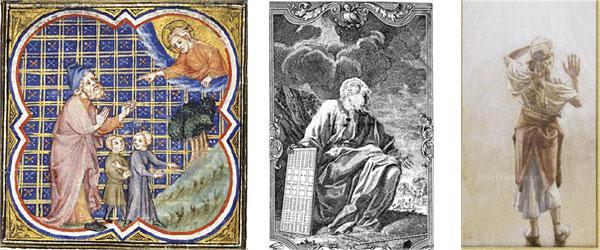
ca. 1900
None of the art on this scene deals with the issue of his virtue, relative or otherwise; it is simply hard to show this. Rather, artists related to Noah`s emotions. Above left, a fourteenth century manuscript clearly shows Noah`s shock and dismay, hands raised in disbelief, his face grieved. Three centuries later an unknown engraver shows Noah`s face upturned toward the heavens, his shoulders leading diagonally to an open hand pointing toward as yet unaware humanity and on his right the building plans for the ark, still only on paper. In James Tissot`s painting, we see Noah from behind, painted into a corner, perhaps shielding his eyes, his right hand and leg trying to steady him before God`s oppressive command.
These reflective works, rather than emphasizing the obedient Noah of the biblical text, portray the dilemma of the man who allowed it to happen. The Midrash does not deal with affect as the art does.
Entering the Ark
In Genesis 2, Adam named all the animals that were created just for his companionship, since "it was not good that the Man was alone." According to , these animals were paraded before the man in pairs, male and female. In Genesis 6 and 7, the parade appears again - this time in two's or seven's depending on their sacrificial status - as they are loaded into the ark to be saved from the great flood.
19 And of every living thing of all flesh, you shall bring two of
every kind into the ark, to keep them alive with you; they
shall be male and female. 20 Of the birds after their kind, and
of the animals after their kind, of every creeping thing of the
ground after its kind, two of every kind will come to you to
keep them alive. Genesis 6
2 You shall take with you of every clean animal by sevens, a
male and his female; and of the animals that are not clean
two, a male and his female; 3 also of the birds of the sky, by
sevens, male and female, to keep offspring alive on the face of
all the earth…7 Then Noah and his sons and his wife and his
sons’ wives with him entered the ark because of the water of
the flood. 8 Of clean animals and animals that are not clean
and birds and everything that creeps on the ground, 9 there
went into the ark to Noah by twos, male and female, as God
had commanded Noah. Genesis 7
The bare-bones but evocative description of this event is an invitation to artists; it became one of the most frequently illustrated episodes of the Flood story. The ways in which artists describe the animals entering, living in and leaving the Ark is more than just evidence of their visual imagination: each portrayal is also a statement about the meaning of the entire saga. Thus, the parade of animals has been variously illustrated: from rings of single animals and birds around the ark, pictured as a four-legged chest, in the 6th century mosaic from the synagogue of Misis (Mopsuestia) to a contemporary cartoon, in which pairs of animals do some nervous, anthropomorphic talking as they enter a typical-looking ship.

The New Yorker, 1976
The biblical account does not deal with specific species of animals, but rather with general categories: fowl, beasts (possibly mammals) and creeping things (reptiles?); male and female. One biblical tradition adds a ritual differentiation: pure (by sevens) and impure (by twos). But later interpretation has come up with additional classifications. For example, several Midrashim tell us that Noah chose the animals that crouched at the entrance to the Ark and rejected those that stood. This tradition may be related to the story of Gideon's army (Judges 9). It may also be an expression of preference for docility over aggressiveness. Other Midrashim highlight specific, rare or fabulous animals. But while literature can generalize, artists have to commit to particular species and groupings. In the 13th century mosaics of the Cathedral of San Marco in Venice, Noah separates the carnivores from the herbivores;
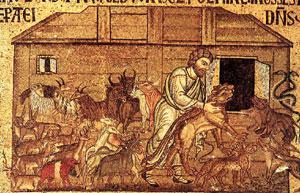
Cathedral of San Marco: Noah bringing the animals into the ark
In the child's drawing below, there are no predators; Noah stands serenely by a pair of house cats (?), as a pair of birds flutter overhead.
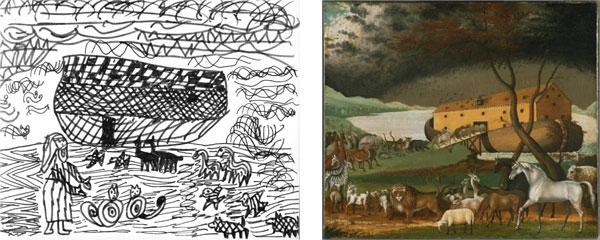
Child's picture Edward Hicks,
Noah's ark, 1846
In American folk painter Edward Hicks' rendition, the only humans visible are vague and marginal; the animals line up patiently in pairs, waiting their turn to enter the Ark under a threatening sky. Note Hicks' crossed trees, a sign of the Cross: Jesus will be the savior from cosmic disaster.
Shalom of Safed has kosher and non-kosher pairs of animals and a lone (pregnant?) elephant (see ), but is mainly concerned with the people who are picking fruit for the journey (above; see Genesis 6:21) and entering the Ark (below).
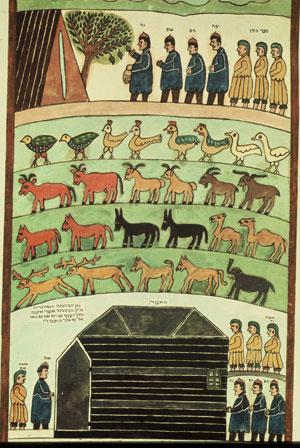
Shalom of Safed, Noah,
Strangely, Shalom has divided the entering group into Shem and his wife at one side and Noah, Ham and Japhet and their wives on the other side of the Ark. We note also that the men are all clean-shaven; is Shalom indicating that all these characters are non-Jews, although Shem's line will eventually produce Israel?
For his part, Rembrandt has no animals at all, focusing entirely on the burdened humans, whose reluctance is patently visible from behind.
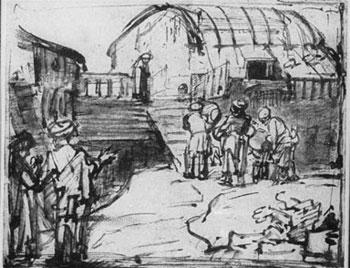
What do these various interpretations convey? The specific example of Hicks' painting may provide a key: His painting of the parade of animals entering the Ark is very similar to his favorite subject, The Peaceable Kingdom
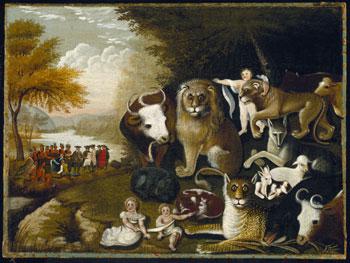
Edward Hicks, The Peaceable Kingdom, ca. 1834
This painting, but one of approximately 80 that Hicks did on the scene, is an illustration of Isaiah's famous vision:
6 And the wolf will dwell with the lamb,
And the leopard will lie down with the young goat,
And the calf and the young lion and the fatling together;
And a little boy will lead them.
7 Also the cow and the bear will graze,
Their young will lie down together,
And the lion will eat straw like the ox.
8 The nursing child will play by the hole of the cobra,
And the weaned child will put his hand on the viper’s den.
9 They will not hurt or destroy in all My holy mountain,
For the earth will be full of the knowledge of the LORD
As the waters cover the sea. Isaiah 11
According to many commentators (see Maimonides, Mishneh HaTorah, Kings 12; Radak on Isaiah 11), this vision is metaphor for the messianic era of peace: the animals represent various human types. The similarity between Hicks' representations of the Peaceable Kingdom and Noah's ark is suggestive of the idyllic potential in the Ark. Hicks (and others) may be saying that the Ark's passengers also represent the human community. The Flood was necessitated by the corruption of humanity and of the entire world by violence. The Ark is a refuge and serves as a laboratory for humans and animals to discover how to live together in peace. If the animals can get along, there might be hope for humankind, for a Peaceable Kingdom.
As a result, there is no need for Hicks or Rembrandt to show both animals and men: Hicks centers on the animals and Rembrandt on the humans, but they are referring to the same thing.
The dominant feeling expressed in the visual art is one of calm and order. But what will happen once all the animals are confined in close quarters, for an extended period? How will such diversity remain calm and orderly?
On board the Ark
The biblical account tells us nothing regarding the conditions inside the Ark, during the full year in which its residents/inmates were confined to its quarters. But an artistic model/pattern appears during the medieval period in which each animal or pair of animals has its separate "stateroom".
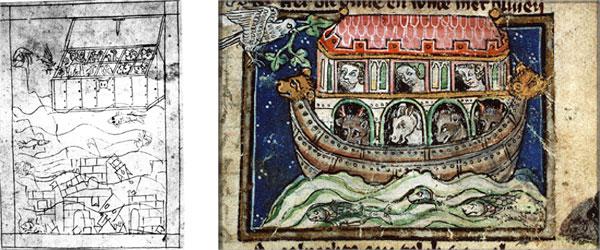
Spain, ca. 1300 with an olive branch to Noah in the Ark,
a. 1325 - 35
While the two 14th century examples seen above differ widely in their general iconography, both picture the animals within individual compartments. Apparently, this commonality is a result of trying to imagine how the many animals, normally hostile to one another, could have endured and survived such extended enclosure. Note, however, that in the Spanish haggadah, as in other cases, the animals are pictured as couples, while the Flemish rendition sees only individuals in each cabin. According to some midrashic sources, no sexual activity was allowed man or beast during their stay in the Ark. Thus, the separate dormitories may have enabled one problem, while solving another.
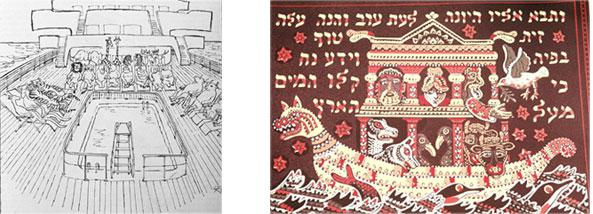
Mischa Richter, Life on the ark Ori Sherman,
The doomed
A much darker scene from the Flood story treated frequently by artists is of doomed humanity trying to save themselves. There is no description of this scene in the biblical account; artistic renditions are therefore almost entirely products of the artists' imaginations. What motivated artists to paint this unrecounted scene?
The earliest extant illustration of the doomed is found in the 6th century Vienna Genesis.
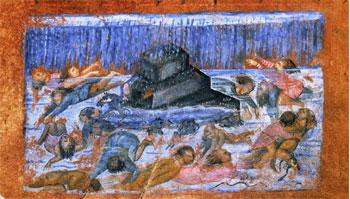
Around a three-tiered, sealed Ark, men, women, children and animals struggle vainly to stay afloat in the rising waters; several figures near the top extend their hands toward the Ark, apparently reaching out for possible rescue, while one discouraged figure dives from the closed Ark into the sea.
The most famous treatment of this scene is one of the three paintings of the Noah story in Michelangelo's Sistine Chapel frescoes.
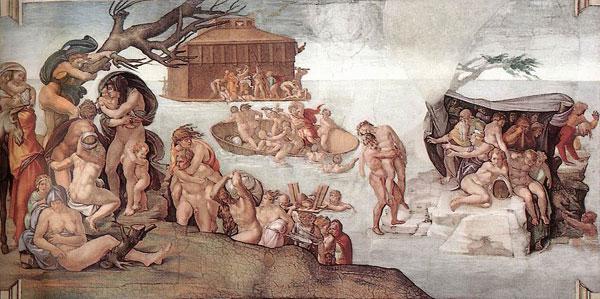
Michelangelo, The Deluge, 1512
Since this is Michelangelo's only painting of the Flood itself, it is important to notice that he chose to focus on doomed humanity, while the Ark is seen only in the distance. One explanation of this viewpoint is that it is derived from St. Augustine's commentary on the Ark story. Augustine interprets the Ark as the Church, which he designates as the City of God, as opposed to the City of Man or sinful, rejectionist humankind. According to his scheme, only Noah and his sons out of all humanity were worthy of inhabiting the City of God and surviving the Flood - all others had to die. In Michelangelo's fresco, together with examples of family devotion, we see a group of people fighting for place in a life boat and another crowd clamoring to gain entry into the tightly sealed Ark.

Hans Baldung Grien, a German contemporary of Michelangelo, dealt frequently with religious and allegorical subjects. But his only treatment of the Noah narrative pictures the frantic attempt of the doomed to break into the Ark, represented as a treasure chest, including a lock on its front door.
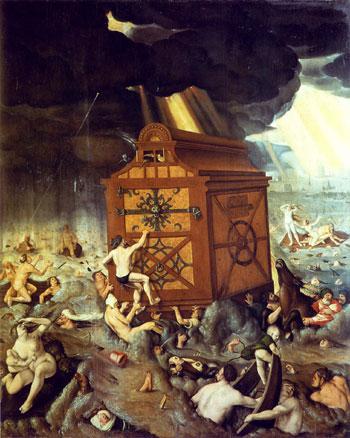
Hans Baldung Grien, The Flood, 1516
The scene is reminiscent of Bosch's famous portrayals of Hell, with contorted bodies heaped around surrealistic objects; but here, the artist is imagining the legendary past rather than the theological future. Michelangelo's and Grien's musings on the doomed are similar to several striking midrashim, including the medieval Book of Jashar:
And the sons of men approached in order to break into the ark,
to come in on account of the rain, for they could not bear the rain
upon them. And the Lord sent all the beasts and animals that
stood round the ark. And the beasts overpowered them and drove
them from that place, and every man went his way and they again
scattered themselves upon the face of the earth.
Nineteenth century French artist Gustave Dore treated the doomed in two renditions.
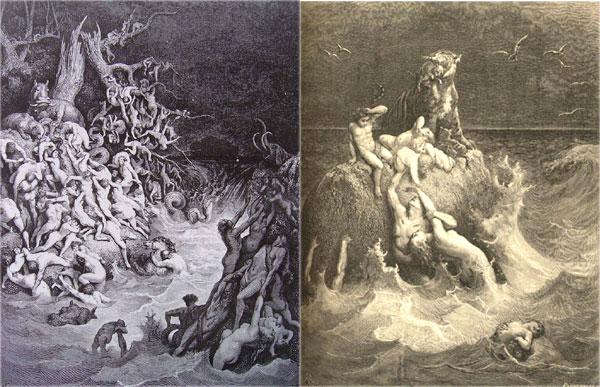
Gustave Dore,
Neither of these engravings includes the midrashic attempt to break into the Ark; in fact, the vessel appears only in one of Dore's pictures, and there vaguely. But on the left we see once again a Bosch-like heap of bodies, curled around one another in poses reminiscent of the famous hellenstic sculpture of Laocoon and his sons. Careful examination of this version reveals a number of animals among the doomed; some are participants in the frantic struggle for survival, others are already preying on other victims. In contrast, Dore's second treatment includes only a small group of people and a very noticeable tiger; here, both humans and animals are attempting to save their children. Thus we find two contrasting artistic views of this scene: in one (Grien, Dore's massed version and parts of Michelangelo's painting), the sinners are only interested in themselves and are once again resorting to violence in order survive; in the other (other parts of Michelangelo's rendition and Dore's second version), the doomed are shown in a more positive light, sacrificing themselves for the sake of their loved ones. These opposing approaches might be compared to various versions of the drowning of Pharaoh's army at the Red Sea. Further, we note that in several literary and artistic treatments, animals are included, both in order to reflect the destruction of all life as indicated in the biblical account and as symbols of humanity's best and worst side(s).
The common feature of all these portrayals is that the Ark is sealed; the survivors and the doomed are separated completely, with no possibility of change. On the one hand, this situation is simply a faithful reflection of the biblical account, according to which all life except those divinely ordained are to be wiped out. On the other hand, various Midrashim have voiced reservations regarding Noah's righteousness, for not advocating for humanity's survival. Some are critical of Noah's passivity toward his fellow men in contrast to Abraham's heroic activism regarding the threatened destruction of Sodom and Gomorrah. Others (see The Book of Yashar 5:8) justify Noah by generating a period of 120 years during which he attempted to reform humanity. Both of these Midrashic tendencies, like some of the artwork, express discomfort over harsh divine Justice and over human apathy toward the plight of their fellows.
The birds
Another scene from the Ark narrative that many artists have treated deals with the beginning of the recovery process.
4 In the seventh month, on the seventeenth day of the month, the ark rested upon the mountains of Ararat. 5 The water decreased steadily until the tenth month; in the tenth month, on the first day of the month, the tops of the mountains became visible.
6 Then it came about at the end of forty days that Noah opened the window of the ark which he had made; 7 and he sent out a raven, and it flew here and there until the water was dried up from the earth. 8 Then he sent out a dove from him, to see if the water was abated from the face of the land; 9 but the dove found no resting place for the sole of her foot, so she returned to him into the ark, for the water was on the surface of all the earth. Then he put out his hand and took her, and brought her into the ark to himself. 10 So he waited yet another seven days; and again he sent out the dove from the ark. 11 The dove came to him toward evening, and behold, in her beak was a freshly picked olive leaf. So Noah knew that the water was abated from the earth. 12 Then he waited yet another seven days, and sent out the dove; but she did not return to him again. Genesis 8
This vignette, like other components of the biblical account, parallels the ancient Mesopotamian epic of Gilgamesh:
On Mt. Nimush the boat lodged firm,
Mt. Nimush held the boat, allowing no sway.
One day and a second Mt. Nimush held the boat, allowing no sway.
A third day, a fourth, Mt. Nimush held the boat, allowing no sway.
A fifth day, a sixth, Mt. Nimush held the boat, allowing no sway.
When a seventh day arrived
I sent forth a dove and released it.
The dove went off, but came back to me;
no perch was visible so it circled back to me.
I sent forth a swallow and released it.
The swallow went off, but came back to me;
no perch was visible so it circled back to me.
I sent forth a raven and released it.
The raven went off, and saw the waters slither back.
It eats, it scratches, it bobs, but does not circle back to me.
Gilgamesh, Tablet XI
While literary scholarship has attempted to explain the symbolism of the three birds in the Gilgamesh Epic and the differences between the Mesopotamian and biblical accounts, inspection of the artistic renditions of this scene indicates that the raven and the dove are treated as diametrical opposites. Most apparent is the difference in color of the black raven and the white dove. In some renditions, this contrast is emphasized simply by showing the two birds in the same illustration;
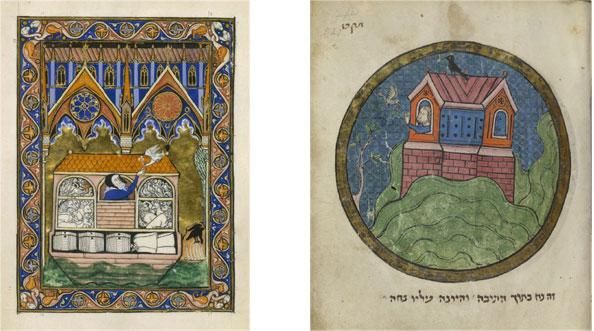
in other cases, each bird appears several times as a means of portraying the various stages of flight and return.
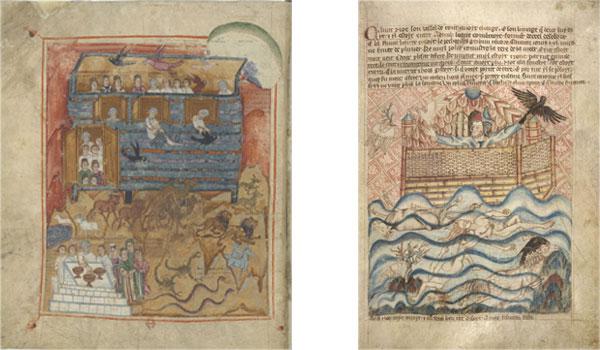
ca. 1320 - 1330
In both cases, the contrast is often further heightened by showing the raven as a scavenger, resting on and eating the drowned bodies of animals or humans. The character of the dove is further stressed by the olive branch it carries in its beak. The contrast between these two birds took on a theological and moral character already in the writings of Jerome, the writer of the Latin translation of the Bible or Vulgate:
The raven also is sent forth from the ark but does not return, and afterwards the dove announces peace to the earth. So also in the Church's baptism, that most unclean bird the devil is expelled, and the dove of the Holy Spirit announces peace to our earth.
Other renditions focus solely on the dove; in most of these cases the dove has become a symbol of joy and peace.
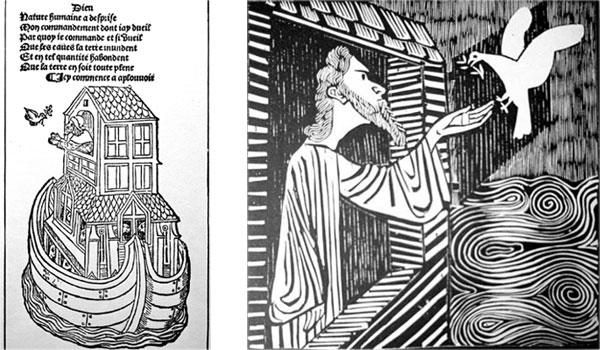
Le mistere du viel testament: Gerhard Marks, Noah with dove,
But strangely Dore's rendition of the flight of the dove includes no olive branch, but rather centers on the dove hovering below the Ark over a desolate landscape in which the scattered remains of drowned humanity lie. It is a ray of hope of recovery for humanity.
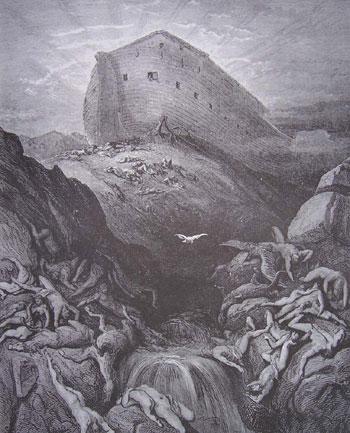
In our own troubled times, the Ark is again a ubiquitous icon, often expressing our anxieties regarding the future.
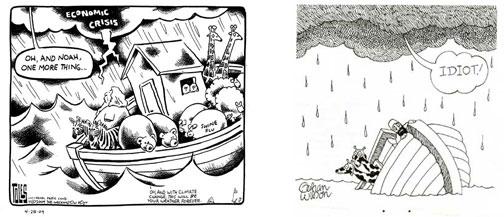
Tome Toles, April 2009 Gahan Wilson, January 2009
The rainbow
In one of the last scenes of the biblical story, Noah offers a sacrifice to God and receives a divine promise that life will never again be exterminated by a flood. The sign of the promise is a rainbow:
20 Then Noah built an altar to the Lord, and took of every clean animal and of every clean bird and offered burnt offerings on the altar.
21 The Lord smelled the soothing aroma; and the Lord said to Himself, I will never again curse the ground on account of man, for the intent of man’s heart is evil from his youth; and I will never again destroy every living thing, as I have done.
22 While the earth remains, seedtime and harvest, and cold and heat, and summer and winter, and day and night shall not cease. Genesis 8
12 God said, This is the sign of the covenant which I am making between Me and you and every living creature that is with you, for all successive generations;
13 I set My bow in the cloud, and it shall be for a sign of a covenant between Me and the earth.
14 It shall come about, when I bring a cloud over the earth, that the bow will be seen in the cloud,
15 and I will remember My covenant, which is between Me and you and every living creature of all flesh; and never again shall the water become a flood to destroy all flesh.
16 When the bow is in the cloud, then I will look upon it, to remember the everlasting covenant between God and every living creature of all flesh that is on the earth.
17 And God said to Noah, This is the sign of the covenant which I have established between Me and all flesh that is on the earth. Genesis 9
The earliest image of the rainbow we know of is in the Vienna Genesis.
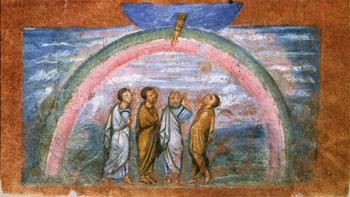
Noah and his three sons stand beneath the rainbow, contorted in wonder, gaping upward at the presence of God.
In the 12th century treatment of the mosaics at Monreale, the rainbow emerges from the altar and connects with Noah`s entire family.
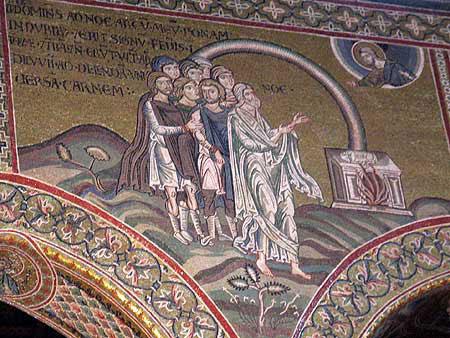
Cathedral of Monreale, The covenant of Noah
The connection is an expression of the biblical juxtaposition of the sacrifice with the rainbow as well as stressing the reciprocity of worship and promise. The curves of the cathedral`s arches, of the rainbow and of the nimbed God form a delightful visual counterpoint.
Contemporary artist Dan Rubenstein created stained glass windows for the Misgav Ladach hospital in Jerusalem, which interpret episodes from Genesis, including the Flood narrative as a new creation.
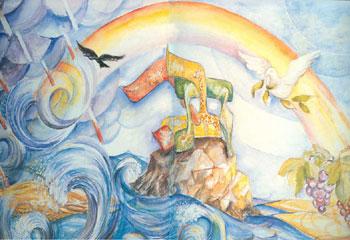
Rubinstein`s ark is made up of three letters—tav, bet, heh—the word tevah, which has multiple meanings: ark, the cradle-boat of the baby Moses, the Holy Ark and simply "word." As the first Creation was achieved through the Word of God, so this new creation is enabled by the "word" of God, affirming the continuity of life. Anne Kilmer, a professor of Assyriology, suggests that the duration of the Flood adds up to the gestation period of the human embryo, a new creation.
As we have already seen, the Flood narrative is similar to the Babylonian Epic of Gilgamesh in many respects. Here the rainbow has a startling parallel:
Seven and seven cult vessels I put in place,
and (into the fire) underneath (or: into their bowls) I poured
reeds, cedar, and myrtle.
The gods smelled the savor,
the gods smelled the sweet savor,
and collected like flies over a (sheep) sacrifice.
Just then Beletili (= Ishtar) arrived.
She lifted up the large jewels which Anu had made for
her liking:
You gods, as surely as I shall not forget this lapis lazuli
around my neck,
may I be mindful of these days, and never forget them!
The Epic of Gilgamesh, Tablet XI
Both in the biblical account and the Babylonian epic, a sacrifice is made after the exit from the ark, followed by a promise not to repeat the devastation. But in the Babylonian version, the sign of the promise is the necklace of the goddess Ishtar. Such a lapis lazuli necklace, blue like the heavens, was found in the Temple of Ishtar in the Babylonian city of Mari, dating from the mid-third millennium BCE.
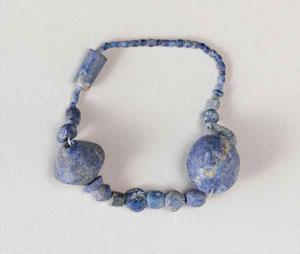
The two arched symbols are similar in shape; the difference is their color. While the blue necklace represents the sky (nature will be benevolent), the rainbow is the totality of colors, God`s benevolent light. As the community of animals represents the peaceable human community, the variety of colors represents the harmonious blending of elements, a sign of hope for the future.
For additional images on this subject see TALI Visual Midrash



